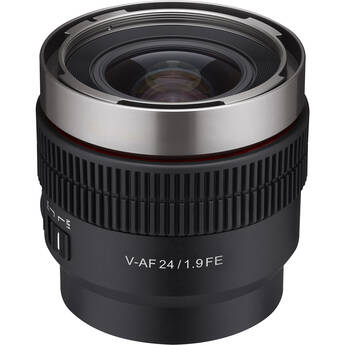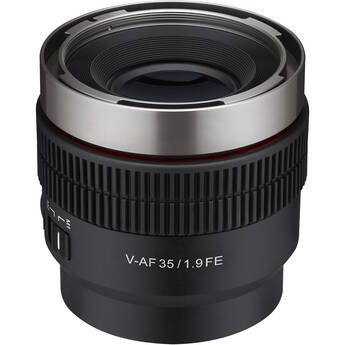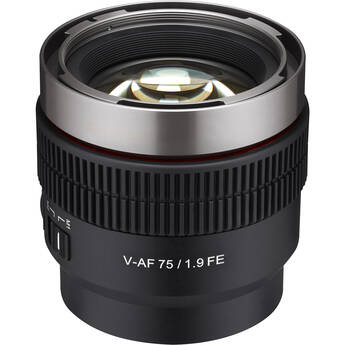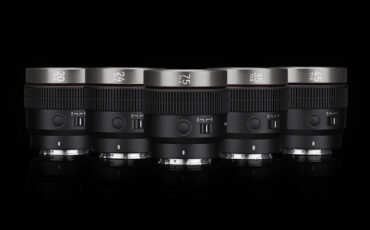Samyang V-AF Review – Best Option for Small & Lightweight E-Mount Primes?
Samyang was kind enough to send us some primes of their V-AF series for E-mount to test in the field. These small lenses are perfect to use on a gimbal and have some surprising features. But are they really the best option currently on the market? Let’s take a look at this new series of lenses that have received unjustifiably little coverage in the media so far – the Samyang V-AF series of E-Mount primes. Let’s get started!
You might know the South Korean brand Samyang by the name Rokinon, especially if you’re in the US. Samyang calls their new V-AF lenses “The World’s First Cine AF”, which is quite a daring statement, to be honest. We have seen other lenses primarily geared toward video use that also feature autofocus capabilities. However, admittedly, there aren’t many comparable alternatives to this series available.
Samyang V-AF – E-mount only
The Samyang V-AF series comes only in E-mount, which limits them to the use on Sony cameras. In total, five different focal lengths were announced: 20mm, 24mm, 35mm, 45mm and 75mm, all except the 20mm which have been released so far. We kindly received the 24mm, 35mm and 75mm for testing purposes. So let’s dive into the review!
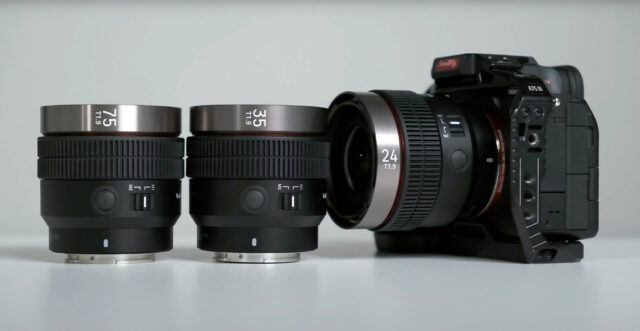
Same size & weight across the line – perfect for gimbals
What’s amazing about the series is their low weight and uniformity, as they all share the same weight at 280 grams, as well as the same size and all of them have an aperture of f/1.8 (T1.9). Though the 20mm lens, which hasn’t been released, doesn’t have a confirmed size yet, the wider-angle options are usually outliers that require a larger diameter. Longer focal lengths often make lenses physically longer, too – but that is not the case here. As you can see in the picture above, the 75mm has the same size as the 24mm and 35mm lenses.
The Art & Science of Lenses
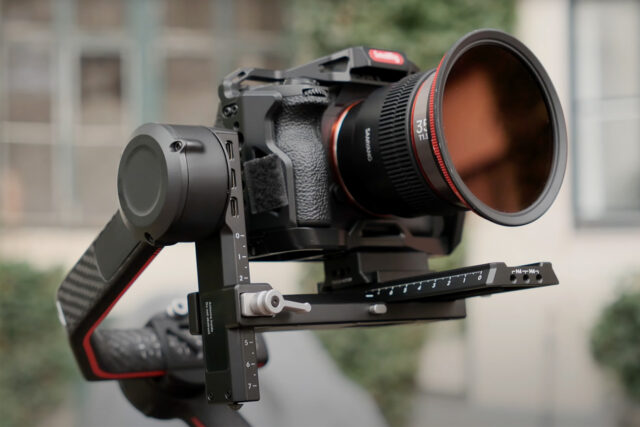
Even the center of gravity stays the same on these lenses. I have no idea how Samyang achieved this, but that really makes them amazing for use on gimbals. I use the a7S III on a DJI RS3 gimbal all the time and no rebalancing is required when swapping between the lenses. Although rebalancing isn’t as time-consuming as it used to be when gimbals had a lot weaker motors, it usually still takes some time to rebalance when you swap lenses. Though, this is simply not the case here anymore.
A look at the exterior of the Samyang V-AF lenses
Before looking more closely at optical performance, let’s stick with the externals of these Samyang V-AF lenses for a bit longer. As mentioned before, they are lightweight, and in order to achieve that, all of the housings are made from plastic. However, I don’t think it feels cheap and if I had the choice, I’d much rather go for this lighter autofocus lens that is made for a gimbal, than for a heavier version made from metal that will make day-to-day operation on a gimbal much more cumbersome.
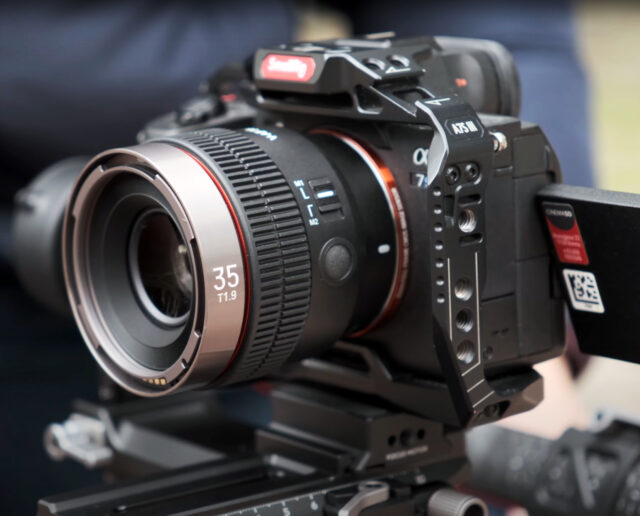
Gear ring and linear focus transition in manual focus
All the lenses come with a built-in gear ring that has a 300-degree turn when operating the lenses manually, which means you can make fairly precise manual focus moves. Of course, hard stops on either end are missing, which would make these lenses more cinema-lens-like, but that is something that probably simply cannot be easily added to lenses that also have autofocus capability.
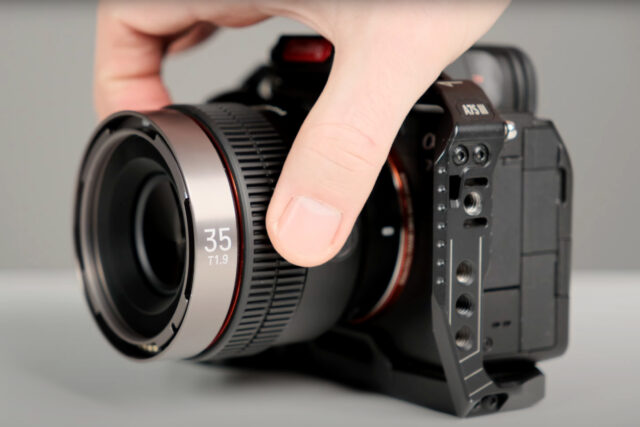
What’s really nice about the manual focus is that this is a linear focus transition, so the movements are repeatable, which is not the case with some competing lenses that operate with the so-called “fly-by-wire” manual focusing method. Take the ZEISS Batis series for example (check out our review here) – they are also autofocus lenses made for Sony’s E-mount and are similar in size and weight – yet when switching them to manual focus, you have to live with a fly-by-wire mechanism of focusing them, which makes focus markings on the lens useless since you can’t repeat the same focus movement unless you hit the exact same speed every time you turn the barrel – which is almost impossible. What’s important to point out here is also that the ZEISS Batis lenses are also a lot more expensive than these Samyang V-AF lenses.
Switch gear ring function from AF to aperture control
On the side of each Samyang V-AF lens, there is a custom switch that allows you to toggle between two positions, M1 and M2. M1 gives you control over the manual focus when your camera is in MF or DMF mode, and M2 lets you control the lens’s aperture using the gear ring when in autofocus mode. So basically the switch changes the function of the gear ring itself. However, you will have to switch your camera between manual and autofocus modes in order to use both modes under the switch. Samyang also has a separate product called “Lens station” which allows you to change the setup of the modes. We did however not receive a lens station and can therefore not comment on what exact functionality of the modes can be changed, but the company also said that more alternative functions would be added through firmware updates in the future.
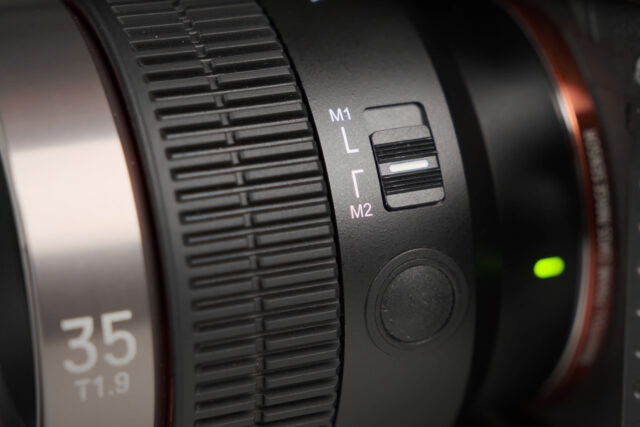
There is also a Focus Hold button on the side, which lets you lock the focusing distance that is currently set in the lens. So for example, if your autofocus sets on something and you want to hold that focusing distance, just press that button and the focus will remain where it is. That’s quite useful when shooting handheld, though not so much on a gimbal as you impact the gimbal’s performance and movability.
Samyang V-AF’s unique features – tally lights and accessory mount on front
Let’s take a look at a few features that really set these lenses apart from the competition.
All of the Samyang V-AF lenses feature two tally lights built right into the lens itself, one on the side of the lens and one in front. You know the camera is recording when the light turns from green to red. That is a neat little feature when working with talents, so you don’t have to constantly be telling them you started or stopped rolling. However, tally lights can create reflections in some shooting situations or when filters are attached. Samyang confirmed that switching the tally lights off using their lens station accessory is possible.
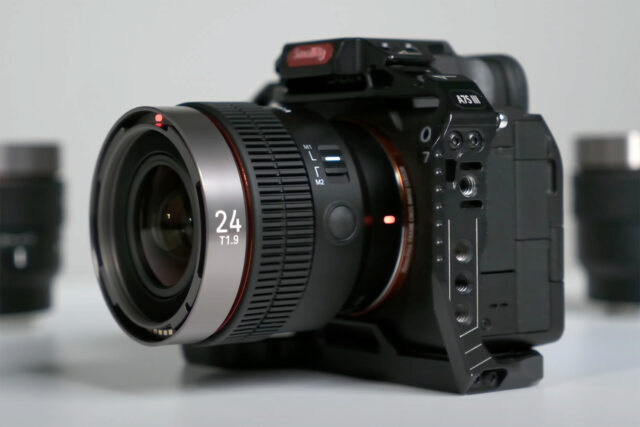
The tally lights are one-of-a-kind, and so is another feature on the Samyang V-AF lenses: they all feature a metal connector with electronic pins in the front. Samyang says that “exclusive accessories” for it will be coming, but released no further details. It’s interesting because it almost looks like a lens mount at the front of the lens, so my best guess is that they’ll release electronically controlled lens filters. I really hope they come up with something special like a variable ND filter that can be electronically controlled through the lens itself. Or an anamorphic adapter for their lenses – there are quite a few great opportunities for this.
I think in any case, it should be a unique kind of accessory because you’ll only be able to use it on the Samyang V-AF lenses. If it’s something that we have already in a universal form, working for all kinds of lenses, its use would be very limiting. The electronic pins give me hope though that it’s going to be something quite unique. As mentioned before, Samyang wouldn’t tell us what’s coming, but they confirmed that the first V-AF accessory will be released quite soon, still during the first quarter of 2023. Later in the year, they will release another one.
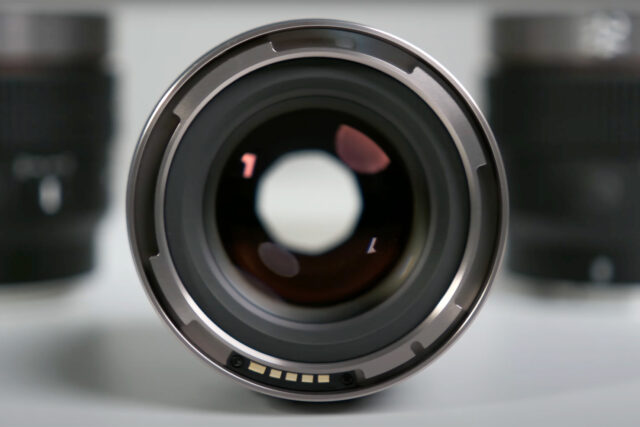
What’s interesting to note is that because of this accessory mount in front, the screw-in front thread is not on the outer barrel of the lens, but inside the accessory mount. The front diameter is 70mm, but the filter diameter is 58mm. According to Samyang, the filter diameter is unconfirmed for the unreleased 20mm lens that will come later this year though. They did however confirm that the accessory mount will work on this wide angle just like on all the other lenses, too.
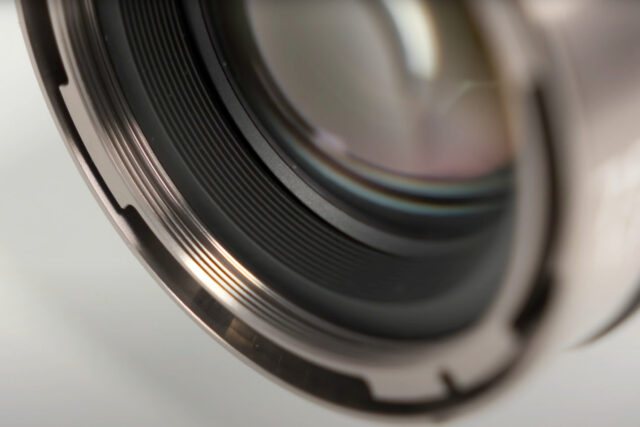
What do images from these lenses look like?
Let’s take a look at the visuals these lenses create.
In general, I like the neutrality of the look with these lenses. They have a pleasing bokeh that looks rather soft, yet the character is quite straight, which means they will cut well with many other lenses. Flares are absolutely minimized too.

What stands out is again the uniformity, even in the look of these lenses, as the three focal lengths we tested look very similar when cut next to each other. You might think that’s a given with a lens series, but with some other manufacturers, there are bigger differences between lenses even within the same series.

Shooting some charts in the studio, we do see only a little bit of vignetting and sharpness fall-off in the corners particularly the wider lenses when shooting wide open, but the effect is very small and not severe at all. An impressive result from lenses this small, and for this price.
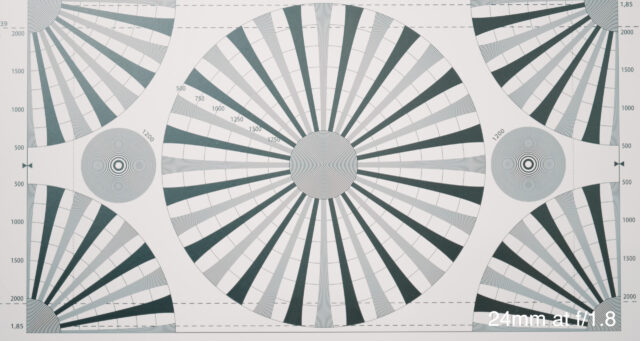
The lenses do have some focus breathing which is certainly unavoidable given their small size. It is noticeable but not problematic in practice – here, the small build size really trumps this minor downside. I’d rather have a small kit of prime lenses ideal for a gimbal with some breathing, than much larger and heavier lenses that I will have trouble balancing on a gimbal.
Chromatic aberration is slightly visible the further you go away from the center of the lens, but also nothing unexpected from a lens with a price/performance ratio of the Samyang V-AFs.

Sharpness looks good and even shooting wide open at f/1.8, they’re still reasonably sharp. The sharpness becomes even better from about f/2.5 on most of these lenses, so just keep that in mind if you are going after the maximum sharpness in your look. For me, it’s amazing that this set of lenses all start at the same aperture of f/1.8, which makes them extremely versatile.
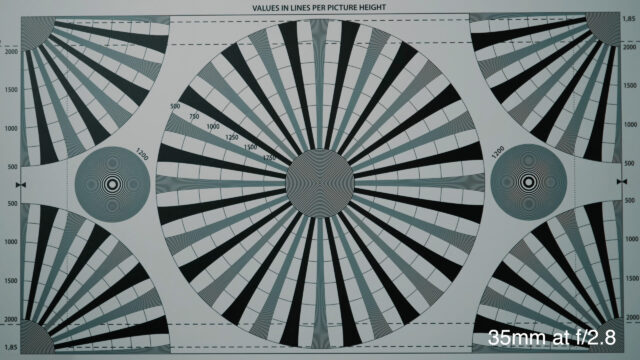
There is some vignetting visible, but this can usually be easily corrected with software if needed. I don’t mind some vignetting as it makes for organic-looking images and focuses the attention of the viewer on the middle of a shot.
Autofocus capabilities of the Samyang V-AF line
Now let’s take a look at the autofocus capabilities. When testing the autofocus it becomes immediately apparent that video has been the focus when developing these lenses. Focus changes are always gentle between subjects, and face focus tracking works extremely well, even at T1.9, wide open. There were a few occasions when the autofocus was thrown off, but that was probably not the lens, but the camera misinterpreting something in the background for a face.
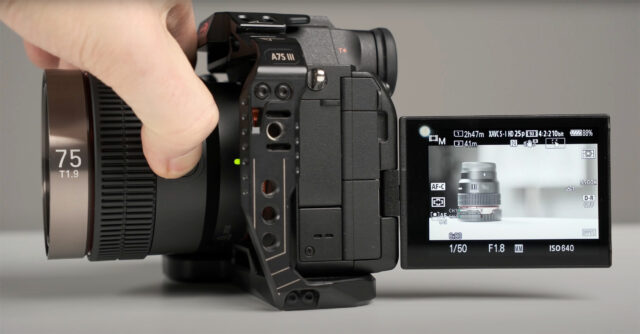
With more photo-oriented autofocus lenses, the focus changes in AF mode can sometimes be jumpier, and almost instantaneous if the camera setting is on the fastest AF transition speed. That’s not very useful for video shooting except on some rare occasions, which is why Samyang apparently optimized the lenses for optimal video performance in AF mode, which in general means a slower AF transition speed. If you are in one of those rare situations where you need to refocus very fast while shooting video, I recommend switching the lens to manual focus, because even at the highest AF transition speed set in camera, the lenses will make focus shifts look more gentle and cinematic.
Conclusion and final thoughts
In my opinion, the Samyang V-AF series of “Cine AF” lenses are a good investment if you are after a cost-effective and lightweight set of primes for your Sony E-mount camera. Particularly, if you predominantly use them with autofocus, and occasionally manual focus. They are really perfect on the gimbal, which is what I will mostly use them for, and also on larger drones with mirrorless cameras. The fact that the lenses are also all the same in weight and size makes them the go-to choice for gimbal operators using a Sony. Autofocus works great, the bokeh is soft and pleasing and their look is quite neutral and clear, which makes these lenses usable and adaptable for most productions.
What is your impression of the Samyang V-AF primes? What small and light primes do you use on your Sony camera? Let us know in the comments below.
